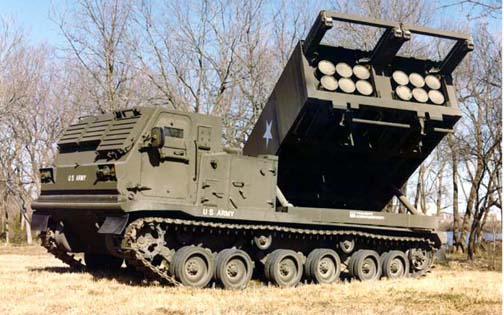About 90 MLRS launchers were committed to Operations Desert Shield/Desert Storm, with more than 10,000 rockets fired during battle. The military report Desert Score summarizes of this system, “The MLRS is also identified as the M270 Armored Vehicle Mounted Rocket Launcher (AVMRL). It consists of an M269 Launcher Loader Module (LLM) with two 6-cell rocket Launch Pods/Containers (LP/c) mounted on an M993 carrier vehicle. Its role is to bombard enemy formations from as far as 20 miles (32 km) away. A full salvo of twelve 227 mm ripple-fired rockets with the Dual-Purpose Improved Conventional Munitions (DPICM) submunition warhead will saturate a 60-acre (24 hectare) area with 8,256 anti-personnel bomblets in less than one minute.” The editors of Jane’s Weapons Systems, 1989–89 write, “The multiple launch rocket system is a highly mobile automatic rocket system developed to enable a firing crew with a minimum amount of training to shoot a complete 12-rocket load, reload rapidly and fire again.”
With two 6-rocket launchers, the MLRS can fire a warhead a maximum of 19 miles (30.5 km) with the M77 submunition warhead and up to 24 miles (38.6 km) with the AT-2 antitank mine warhead. Rocket size is 13 feet × 9 inches (4 m × 33 cm). Powered by a Cummins VTA-903 903 cubic inch (14.8 liter) liquid-cooled V-8 diesel engine, the vehicle, which is essentially a modified M2 Bradley APC, is crewed by three men (section chief, gunner, and driver). It is built by FMC of San Jose, California, and LTV of Dallas, Texas.
The MLRS is primarily a counter fires and battlefield shaping weapon, not used to close support of friendlies. It primary means of targeting is through the various sensors that support the force as a whole. However, MLRS can be still be assigned the mission of reinforcing and general support reinforcing. When that is done it can be shot close to friendlies, if the reinforced artillery unit’s supported unit is willing to take the chance. Although it can be used as close a 5KM from the launcher, normally 10KM is the min range. The current danger close (if you can even call it danger close, since the DPICM produces kill zones, etc) for MLRS is listed as 2 KM; however, in the near future they will be going to PI figures of acceptable risk. The 10% PI figure is around 650 m.
Although the manufacturer claimed higher numbers, the official report on the conduct of the Persian Gulf War stated that 189 SPLLs had fired 9,660 rockets.
Most of the launchers were with US Army forces; the first US combat use came in mid-February as part of the preparation for the ground campaign. Generally, reports on the effectiveness of the weapon were very favorable, with a large percentage of Iraqi targets destroyed.
According to some reports, the rate of fire was described as “steel rain,” allegedly coined by Iraqi soldiers to describe MLRS bombardments.
12 British MLRS launchers fired over 2,500 rockets during Desert Storm. As evidence of the system’s destructive power, the British noted an Iraqi brigade that began with 80 artillery pieces and lost only 20 to air attacks over a period of weeks. After the MLRS barrages, only seven pieces remained operable.
Multiple Launch Rocket System M270A1 (MLRS M270A1)
Lockheed Martin is under contract to incorporate two new upgrades to the current MLRS system. The new M270A1 launcher appears identical to existing M270s while incorporating an Improved Fire Control System (IFCS) and an Improved Launcher Mechanical System (ILMS). M270A1 launchers feature improved survivability, reduced operating cost, increased munition options and GPS navigation. The U.S. Army will begin converting the U.S. MLRS fleet to M270A1 in 2002.
Greatly increased responsiveness
Meets Digitized Corps requirements
83 percent reduction in aim time
38 percent reduction in reload time
38 percent reduction in O&S costs
State-of-the-art electronics
Embedded GPS/Inertial Navigation System
First Unit Equipped in FY02
Advanced fault isolation capability
References:
Almond, Denise L., ed., Desert Score: U.S. Gulf War Weapons (Washington, DC: Carroll Publishing, 1991), 378–379;
“America’s Arsenal,” Popular Mechanics, 168:4 (April 1991), 30;
Blake, Bernard, ed., Jane’s Weapon Systems, 1988–89 (Coulsdon, Surrey, UK: Jane’s Information Group, 1988), 133–134.
